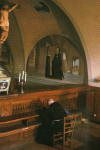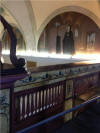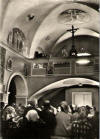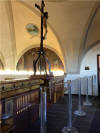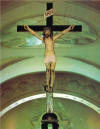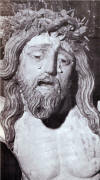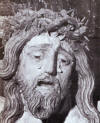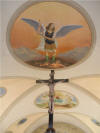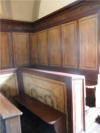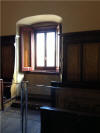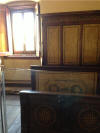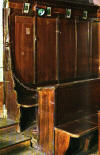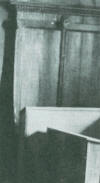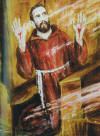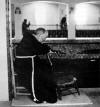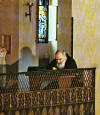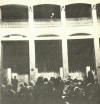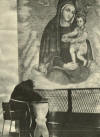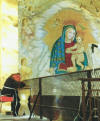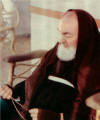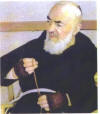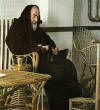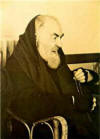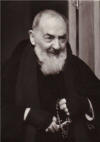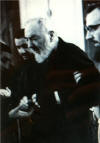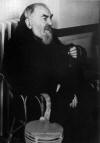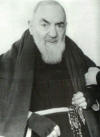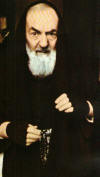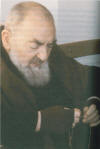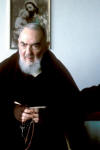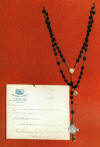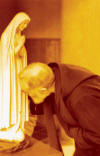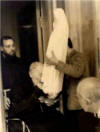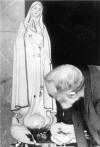16a The Holy Virgin
Mary
Names
Padre Pio called Mary in many different ways.
Some of them: Maria, Madonna, Mamma, Mammina, Madre, Madonnina,
Madonnella, Signora, Vergine Maria, Madre Maria, Diletta Madre, Tenera
Madre, Madre mia cara, Celeste Madre, Madre di Misericordia, Bianca
Signora, Maria Santissima, Mamma mia, Madre Immacolata, Santissima
Vergine, Cara Madre, Mamma dolcissima, Madonna Mia, Mamma nostra, Dolce
Signora, Vergine Santa, Madonna delle Grazie.
[1]
Calm down!
Padre Pio wrote on August 15, 1929, feast of the Assumption: “This
morning I approached the altar with physical pains and internal anguish.
I felt like dying. I was permeated by a deadly sadness. At the moment of
consuming the Sacred Host I saw clearly the Heavenly Mother with Baby
Jesus in her arms. They both told me: “Calm down! We are here with you.
You belong to us and we are yours.” From that moment I felt drowned in
an indescribable sea of sweetness and love.”[2]
Pompei
Padre Pio wrote that since 1912 he had prayed “novenas after novenas” to
the Madonna di Pompei “for more than three years” to obtain the grace to
return in convent. He was able to return and stay in convent in 1916.[3]
Madonna of the Graces
To a woman who had asked for prayers to be healed, Padre Pio said:
"Let's pray the Madonna of Graces. She will heal you."
When the woman returned to tank Padre Pio he said: "Mary healed you, not
me."[4]
Lourdes
Padre Pio described one day to Padre Rosario di Aliminusa in every
detail the sanctuary of Lourdes. He had never been there. Padre Rosario
said: “You must have seen it in a dream!” Padre Pio: “What dream? I was
not sleeping. I was awake!”[5]
To Padre Onorato who was going in pilgrimage to Lourdes: "I have been to
Lourdes many times. You don't need a car or a train, there are other
means too."[6]
To Padre Alessio: “I don’t have to go to Lourdes. I go there every
night. I see Our Lady of Lourdes every night.”[7]
Don’t you see Her?
Padre Agostino was in Padre Pio’s room, when Padre Pio asked: “Don’t you
see the Madonna?” To Agostino’s negative answer Padre Pio replied: “You
deny it for holy humility!”[8]
[9]
Padre Onorato asked Padre Pio if he saw the Madonna. Padre Pio replied:
“She comes to me whenever I need her.”[10]
Padre Tarcisio: “Does Our Lady ever comes to your cell?” Padre Pio:”You
should rather ask me if she ever leaves my cell.”[11]
Padre Marcellino: “Padre Pio solves everything with the help of our
Lady, or by letting her solve it.”[12]
Padre Pio to Padre Pellegrino, who was concerned that Padre Pio was
working too much: “You are tormenting watching me while I hear
confessions, as you had nothing better to do. Our Lady knows. Ask her.
She is the one who brings us a ray of God’s immensity and of divine
powers.”[13]
“There are people so foolish that they think they can go through life
without the help of the Madonna.”[14]
“What could I ever do without her?”[15]
To Padre Pellegrino: “We must fall asleep in the arms of the Holy Virgin
Mary. She is a mother who is deeply in love with us. We should let her
beautiful angels cradle us. You may lough but this exactly the way
things are. Find me one person in this world who is ready to give
everything without for something in exchange! Our Lady, the angels, and
the saints are extremely active for our conversion and salvation. When
he judges us in the last moment of our lives, God will allow Our
Heavenly Mother to act in his place or to be our defense lawyer. She is
the link between humanity and divinity.”[16]
Padre Pellegrino: “One day I asked Padre Pio jokingly: “How do you
manage to keep calm in this environment in which if I had to keep in
control just for one day, I’d either run away or massacre everyone with
a machine gun?” Padre Pio: “Go in church and ask Our Lady the same
question. I am in agony each day, dying little by little without any
plausible reason. I am always in her arms, and she gazes at me sweetly.”[17]
Padre Pellegrino reported what he heard from Padre Pio while he was
praying: “Our Lady, help me. I am assailed by too many devoted people,
too much adulation and too many donations. I can’t go on like this.
Please, help me, Our Lady.”[18]
The candle
One evening Dr. Kisvarday was talking with Padre Pio in his cell when
the light went off. He got up to get a candle. "Where are you going?
There is so much light. We don't need a candle. Don't you see the
Madonna lighting up the cell?" Dr. Kisvarday: “I didn't see the Madonna,
I saw only pitch dark.”
Confessions
On several occasions Padre Pio confided to his intimates that the
Blessed Virgin remained beside him while he heard confessions.[19]
Mary at the Mass
To Enzo Bertani: “Every morning the Virgin Mary is at the altar,
together with Jesus, or the Seraphic Father Saint Francis.”[20]
To Cleonice Morcaldi:
From 1921 to 1923 Padre Pio, as by disposition of the Holy Office, said
Mass alone. Years later Padre Pio told Padre Eusebio: “I was never
alone. Our Lady always kept me company during Mass.”[21]
Two mothers
Sitting in the armchair, few minutes before dying Padre Pio said: “I see
two mothers.” His mom had died many years earlier. He was seeing the
Virgin Mary and Mamma Peppa, his birth mother, together.[22]
The very last word of Padre Pio was: “Mary!”[23]
Prayer
Padre Pio had two favorite prayer spots:
the choir of the old church, and balcony of the new church
Choir
Padre Pio prayed in the original old choir, near the parapet overlooking the church of St. Mary of the Graces. On the arched wall to his right there is the fresco painting of Saint Veronica Giuliani. Veronica had the crown of thorns in 1694, and five the stigmata on her body in 1697.
The choir seen from the nave of the church below.
Padre Pio from his prayer spot could see the nave of the church below, were people stayed in prayer.
When Padre Pio concluded praying, people below stood up, looking in his direction, to be blessed.
The prayer spot as it has been remodeled, is at the right side of the Crucifix.
At the center of the choir there is a large crucifix.
The crucifix came alive in 1918 and gave the stigmata to Padre Pio.
On the ceiling there is a painting of St. Michael defeating the devil.
The right and left side of the choir, with the benches for the friars, as it has been remodeled. The natural light comes from the window where Padre Pio used to stand to bless the pilgrims in the square below. Padre Pio was kneeling on the upper bench, in the spot closest to the window, when he received the wounds.
The spot were Padre Pio was kneeling when he received the wounds. The flower, the sign and the painting indicate the spot. The steps on the far left lead to the window of the blessings.
Balcony
Padre Pio in prayer in the center back of the balcony facing the main altar of the new St. Mary of Graces church.. Fra' Daniele is with him.
On the balcony (matroneo in Italian) of the new church.
 Padre Pio walking with the friars.
Padre Pio walking with the friars.

 At the bottom of the U shaped balcony.
At the bottom of the U shaped balcony.
When Padre Pio was on the balcony he could look at the mosaic of the Madonna. When he walked to reach his prayer spot he could also see the nave of the church below, were people were staying in prayer. When Padre Pio concluded praying, people below were on the lookout, and stood up, looking in his direction, to be blessed.
Padre Pio in the balcony, and the faithful below waiting for the blessing. The same as in the old church.
Padre Pio praying, facing the mosaic of the Madonna of the Graces.
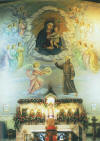
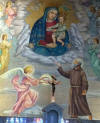 When Padre Pio was proclaimed saint, his image was added to the
mosaic.
When Padre Pio was proclaimed saint, his image was added to the
mosaic.
Padre Pio’s favorite invocation:
"My past, Oh Lord, to your mercy; my present, to your love; my future,
to your providence!"[24]
[25]
Padre Pio:
“Those who pray a lot will be saved. Those who pray a little risk being damned.
Those who don’t pray don’t need the devil to take them to hell; they
will get there on they own legs.”[26]
Books
"We seek God in books, but it is in prayer that we find Him."[27]
[28]
Key
"Prayer is the key that opens the heart of God."[29]
"Prayer must be persistent. Persistence denotes faith."[30]
"Prayer is the best weapon we possess."[31]
[32] "Prayers will never be
wasted."[33]
"I want to save souls by continuous prayer."
[34] "I will never tire of
praying to Jesus."[35]
Agitation
"Pray,
hope, don't get agitated.
Agitation doesn't help at all.
God is merciful and will listen to your prayer."[36]
("Prega, spera, non agitarti. L'agitazione non giova a nulla. Dio è
misericordioso ed ascoltera' la tua preghiera.")
“The more you get agitate, the sooner the Providence will withdraw its
arms from you." "Anxiety makes us run only to make us trip." "Agitation
never comes from God.”[37]
Witness
Padre Lodovico: “He has the appearance of a profound mystic.”[38]
“He protracts his prayer. One tires of waiting for him, especially when
he is meditating.”[39]
Never met
“The Lord presents to me people that I have never met with the purpose
of interceding for them. In such case, it never happens that my prayers
are unanswered. Afterwards I forget totally about them.”
[40]
Waiting for you
Padre Pio was told: “When you leave us what are we going to do without
you?” He answered: "I will be here in your midst, more than before. Come
visit my tomb. Before, in order to speak to me, you had to wait. Then,
it is I who will be waiting there. Come to my tomb and you will receive
more than you did before!"[41]
Suffering
Padre Cherubino: Padre Pio’s life is one of enduring suffering.[42]
Padre Lodovico: “He tries to conceal his suffering with special industry
and ingenuity.”[43]
"Jesus doesn't ask you to carry the heavy Cross with Him; just a small
piece."[44]
Asked by Mons. Rossi if he did penitential practice, Padre Pio said: “I
don’t do penitential practices. I take the ones the Lord sends. I have
been forbidden penitential practices, on account of my poor health.”[45]
“What kind of heaven would be if we didn’t have with us those whom we
love?”[46]
To Padre Marcellino: “Padre Pio only speaks once.”[47]
Rosary
Padre Pio had always a rosary in his hands:
Padre Pio
"Always recite the rosary and recite it as often as possible."[48]
Weapon
To Padre Onorato Marcucci, grabbing the Rosary that he had put few
seconds on the nightstand: "This is
my weapon.
With this, one wins the battles."[49]
Witnesses
Padre Fernando da Riese: “The Rosary was Padre Pio’s favored prayer. He
prayed it many times a day, decade after decade. He had always a rosary
wrapped around his hand or arm, as it was a jewel or a shield. He had
other rosaries under the pillow and on the nightstand. He called the
rosary his “weapon”. He had made a resolution years earlier to say
“daily no less than five complete rosaries.””
[50]
Padre Domenico Mondrone: “Padre Pio honored the Madonna every day
praying a countless number of rosaries.”[51]
Padre Rosario da Alminusa: “Padre Pio had always a rosary in his hand,
and at night, when he almost never slept, he passed ht hours reciting
the rosary.”[52]
Padre Marcellino testified that he had to help Padre Pio wash his hands
one at a time "because he didn't want to leave the rosary beads, and
passed the Rosary from one hand to the other."
How many Rosaries
February 6, 1954 9:00 PM, to father Carmelo: "I still have 2 rosaries to
pray today. I said only 34 so far. Then I will go to bed."[53]
Answering to Padre Michelangelo: "Today I said 32 or 33 rosaries. Maybe
1 or 2 more."
Answering to Padre Mariano Paladino da Magliano Santa Croce: "About 30.
Maybe some more, but not less." 'How do you do it? "What is the night
for?"
To don Pierino Galeone: “Between 15 and 20.”[54]
To Lucia Pennelli one morning around 7:00 AM after Mass: "How many
rosaries did you say so far today?" 'Two". Padre Pio: "I already said
seven."
To Lucietta Pennelli, one day at about noon: "Today I have already said
16 complete Rosaries."
To Padre Tarcisio Zullo asking how many rosaries he said every day : “If
is not a good day, about 30.”[55]
[56]
Padre Alessio Parente asked Padre Pio why he would constantly say the
rosary and no other prayers. Padre Pio: “Because the Madonna never
refuses me anything that I ask through the prayer of the rosary.”
Fatima
Padre Pio healed
In 1959 the Conference of Italian Bishops announced that the statue of
Madonna di Fatima would make a tour of Italian cities and towns.
On April 24, 1959, the Pilgrim Statue of Our Lady of Fatima visited
Italy, starting from Naples. The same day
Padre Pio became very ill. He had broncho pneumonia and couldn’t
celebrate Mass.
[57]
On August 1st Padre Pio was recovered inpatient at Casa Sollievo. The illness continued.
Each evening, by way of a
microphone brought to his cell, he would address a few words to the
faithful. When the illness continued and worsened, a team of doctors
settled on a diagnosis of a tumor of the lungs and recommended
chemotherapy. Padre Pio actually laughed and told the doctors they were
wrong. Out of deference to Padre Pio, the Bishops Conference had
arranged for the “Pilgrim Virgin” to visit San Giovanni Rotondo. The
statue arrived by helicopter from Foggia on August 5. There was a whole
day of prayer before the statue. On August 6, the statue was taken into
the sacristy were Padre Pio had been carried down in a chair. Padre Pio
stooped to kiss the statue and placed his rosary in the Madonna’s hands.
When the statue was about to leave by helicopter Padre Pio has taken to
a window to see the departure. When he saw the helicopter leaving he
broke down in tears and cried: “Mother, I have been sick during your
visit to Italy. Are you now leaving without curing me?” Then Padre Pio
felt a chill through his body. He exclaimed: “I am cured.” He was truly
cured.[60]
[61]
[62]
Padre Francesco Napolitano: “I was present at the scene and can testify
that Padre Pio never felt as healthy as he did after the departure of
the statue of Our Lady of Fatima.”[63]
On August 10 Padre Pio resumed celebrating Mass, and the 21th he resumed
the confessions.[58]
[59]
Bibliography
Agostino, da San Marco in Lamis (2012).
Diario. San Giovanni Rotondo: Edizioni Padre Pio.
Ago12
Alberto, D'Apolito P. (2007). Padre
Pio of Pietrelcina. Memories. Experiences. Testimonials. San
Giovanni Rotondo: Edizioni Padre Pio.
Alb07
Alessando, da Ripabottoni (Saint Pio of
Pietrelcina. Everybody's Cyrenean). 2010. San Giovanni Rotondo:
Edizioni Padre Pio.
Ale10
Castelli, F. (2011). Padre Pio under
investigation. The secret Vatican files. San Francisco: Ignatius
Press.
Cas11
Clarice, Bruno (1970). Roads to Padre
Pio. Roma: Citta' Nuova.
Bru70
Covino, Paolo P. (2007). Ricordi e
testimonianze. San Giovanni Rotondo: Edizioni Padre Pio.Cov07
DeLiso, O. (1962). Padre Pio. New
York: All Saints Press.
DeL62
Gaudiose, D. M. (1974). Prophet of
the people. A biography of Padre Pio. New York: Alba House.
Gau75
Iasenzeniro, F. M. (2006). The
"Padre" saint Pio of Pietrelcina. His mission to save souls.
Testimonies. San Giovanni Rotondo: Edizioni Padre Pio.
Ias06
Ingoldsby, M. (1978). Padre Pio. His
Life and Mission. Dublin: Veritas Publications.
Ing78
McCaffery, J. (1978). Tales of Padre
Pio. Kansas City: Andrews and McMeel.
McC78
Multiple. (2009). Padre Pio The
wonder worker. New Bedord, MA: Franciscan Friars of Immaculate.
Mul09
Napolitano, F. (1978). Padre Pio of
Pietrelcina. A brief biography. San Giovanni Rotondo: Edizioni Padre
Pio.
Nap78
Padre, Pio da Pietrelcina (2010).
Have a good day. San Giovanni Rotondo: Edizioni Padre Pio.
Pio10
Pietrelcina, P. P. (2011).
Epistolario II, corrispondenza con la nobildonna Raffaelina Cerase
(1914-5). San Giovanni Rotondo: Edizioni Padre Pio.
Epist. II
Riese, Ferdinando da (2010). Padre
Pio da Pietrelcina crocifisso senza croce. San Giovanni Roronto:
Edizioni Padre Pio.
Fer10
Schug, J. O. (1987). A Padre Pio
Profile. Petersham, MA: St. Bedès Publications.
Sch87
[1] Fer10, 470, 484
[2] Fer10, 474-5
[3] Fer10, 475
[4] Alb07, 261
[5] Fer10, 477
[6] Gau74, 230
[7] Sch87, 59
[8] Ago12. 53
[9] Ale10, 249
[10] Ing78, 136
[11] Ias07, 661
[12] Ias07, 664
[13] Ias07, 661-2
[14] McC76, 139
[15] Ias07, 661
[16] Ias07, 670-93
[17] Ias07, 693-6
[18] Ias07, 595
[19] Ing78, 136
[20] Ias07, 665
[21] Ias07, 668
[22] Fer10, 488
[23] Ing78, 136
[24] Bru69, 209
[25] Ale10, 310
[26] Ias07, 521
[27] Del62, 547
[28] Pio10, 25
[29] Ale10, 372
[30] Pio10, 28
[31] Del62, 554
[32] Pio10, 24
[33] Pio10, 28
[34] Pio10, 28
[35] Pio10, 29
[36] Pio10, 24
[37] Pio10, 200
[38] Cas11, 191
[39] Cas11, 191
[40] Epist. II, 93
[41] Ale10, 379
[42] Cas11, 198
[43] Cas11, 194
[44] Pio10, 45
[45] Cas11, 213
[46] Mul09, 178
[47] Iase06, 136
[48] Cov07, 163
[49] Nap78, 217
[50] Fer10, 486
[51] Fer10, 392
[52] Pen13, 27
[53] Nap78, 222-3
[54] Gal09, 44
[55] Pena 13, 27
[56] Positio II, 624
[57] Nap78,219
[58] Gau74, 185-6
[59] Nap78,219-21
[60] Gal95, 168-9
[61] Nap79, 219-221
[62] Gia12, 360-3
[63] Nap79, 221
